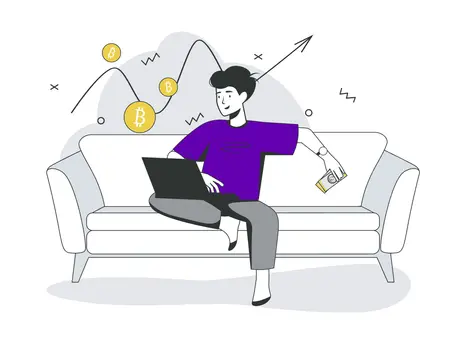How crypto trading works? Strategies to navigate a volatile market
Trading cryptocurrencies can be complex and risky. Learn about market patterns, fundamental analysis, and risk management strategies to make informed trading decisions in this volatile market.

The crypto market has grown tremendously popular in recent years as cryptocurrencies are gradually but surely beginning to take over the world. Since Bitcoin's introduction to the market more than a decade ago, its rapid growth, and its current value approaching that of gold, there has been a frenzied desire from customers.
Timing is everything. Correct timing allows you to reap significantly higher rewards. Depending on the fluctuating value of the underlying asset, the goal is to generate money by either purchasing or selling cryptocurrencies. Since bitcoin prices are still so unpredictable, many traders choose to HODL (hold, in the crypto language) instead since it seems safer and more tempting to them.
Here is a simple guide to understanding what cryptocurrency trading is and how it functions.
What's crypto trading?
Cryptocurrency trading is the act of betting on how the price of a cryptocurrency will change through a contract for difference (CFD) trading account or buying and selling the base coins through an exchange. CFD trading is a type of asset that lets you bet on the price of Bitcoin (BTC) without owning the currency itself.
For instance, you can go long (buy) if you think the price of a cryptocurrency will go up, or short (sell) if you think it will go down. Both are leveraged assets, which means that you only need a small deposit, which is called margin trading crypto, to have full exposure to the underlying market. But because your profit or loss is still based on how much you invested, using leverage to trade crypto makes both your profits and losses bigger.
Also, buyers use cryptocurrency options to lower their risk or get more market exposure. Crypto options trading is a "derivative" financial tool, which means that its value is based on the price of another asset, which in this case is the cryptocurrency.
Before you even think about getting into crypto trading, you should know a lot about the assets and technologies involved. Bitcoin is the groundwork for thousands of other cryptocurrencies.
Like trading stocks and other financial markets, trading cryptocurrency can be complicated and involve a lot of different parts. Bitcoin was the first cryptocurrency when it came out in 2009. It is still the most popular and has the biggest market capitalization.
Over time, though, a whole industry has grown up around other digital goods that can be traded and sold for money. Altcoins are all the other digital currencies that aren't Bitcoin. Ether (ETH) is the biggest one.
Basics of trading cryptocurrencies
We can define the crypto market as a market that never sleeps, determining the value of bitcoin second by second and day by day. Since Bitcoin is an independent digital asset with an open market for determining its value, it has volatility issues in contrast to most currencies.
Therefore, it is crucial for newbies to have a basic understanding of how cryptoasset markets operate so they may traverse the markets securely, even on occasion, and maximize the benefits of their involvement in the crypto trading economy.
The scale and complexity of bitcoin trading can vary from a straightforward exchange for fiat money like the dollar to using a number of trading pairings to successfully ride the market and expand one's investment portfolio. Of course, a trader's risk exposure grows as a crypto transaction's size and complexity expand.
Let's first review some fundamental ideas.
Type of transaction with cryptocurrency
A buyer and a seller participate in a cryptocurrency transaction. Someone will always benefit more from a trade as there are two competing sides—a purchase and a sale. As a result, trading is by its very nature a zero-sum game in which both winners and losers exist. Basic knowledge of how the bitcoin markets function can be used to reduce potential losses and maximize gains.
When a buyer and seller agree on a price, the trade is carried out (via an exchange), and the asset's market value is established. Buyers typically set their orders at a lower price than sellers. The two sides of an order book are thus created.
Cryptocurrency prices often increase when there are more buy orders than sell orders since there is greater demand for the asset. On the other hand, when there are more sellers than buyers, the price drops. Buys and sales are typically represented in distinct colors in exchange interfaces. This is done to quickly inform the trader about the market's condition at any particular time.
You may be familiar with the trading maxim "Buy low, sell high." The adage does provide a fundamental illustration of the incentives of buyers and sellers in a marketplace, but it can be challenging to navigate because high and low prices might be relative.
Simply simply, you want to spend as little money as you can while making a transaction. If you want to sell anything, you want to get the biggest return on your investment. Although this is typically sound advice to abide by, there is the additional consideration of desiring versus shorting assets.
Going long on an asset (longing) is purchasing an asset and making money off of the asset's rising price movement. Contrarily, selling an asset with the goal to buy it back when its value drops below the level at which you sold it in order to profit from a price decline is known as shorting an asset. However, shorting entails the sale of borrowed assets that will be repaid later and is a little bit more difficult than this basic explanation.
Analyzing market data
The truth is that "the market" is just individuals buying and selling things. To the uninitiated, "the market" could appear to be some complicated system that only a professional could ever hope to understand. At first glance, trading cryptocurrencies could appear like a mysterious concept. But once you start to get it, the concept gets a lot clearer.
The sum of all open buy and sell orders represents the state of the market at any particular time. In order to read the market, a trader must continuously look for patterns or trends throughout time and decide whether to act on them. Both bullish and bearish market patterns are present overall.
A "bullish" market, sometimes known as a bull market, is one in which price activity seems to be rising gradually. These price rises, which are often referred to as "pumps," occur as a result of a surge in demand. When the price activity seems to be decreasing consistently, the market is said to be "bearish" or in a bear market. These significant drops in price, which are often referred to as "dumps," occur as a result of widespread selling.
How to start trading in cryptocurrencies
There are many different methods for trading cryptocurrency. One must have sufficient knowledge of cryptocurrencies before they can begin trading them. Additionally, it's important to be aware of the hazards involved and any local regulations that might be relevant before making decisions.
Open an account on a crypto exchange
If you don't already hold cryptocurrency, you will need to create an account with a crypto exchange. Digitra.com is one of them. There is a large selection of alternative coins available on it, and its interface is simple to use.
You must provide personal identifying information to open an account with a cryptocurrency brokerage, just as you would with a stock brokerage. Your address, birth date, Social Security number (if you're in the United States), and email address are among the Know Your Customer (KYC) requirements that must be provided when registering an account.
Put money into your account
Once you've registered with a cryptocurrency brokerage, you'll need to make your first deposit. The most economical method of funding your account is typically a wire transfer. On Digitra.com, you can deposit crypto or fiat currencies.
Pick a cryptocurrency to invest in
Bitcoin and Ether are the two cryptocurrencies that most cryptocurrency traders invest in. However, because big cryptocurrencies move more reliably than smaller altcoins, trading using technical indicators is conceivable.
A lot of cryptocurrency investors invest some of their capital in altcoins. Smaller and mid-market cap cryptos have a larger upside potential despite being riskier than large-market cap cryptos.
Begin trading
The basic process of trading a cryptocurrency consists of making a buying or selling transaction on the crypto exchange on which you've opened an account.
Once you put money on it, check if the exchange platform has the coin pair you're looking for to trade. Ex: if you want to trade USDC-BTC, the platform must have the UDSC/BTC pair.
The detailed process of the transaction will depend on the platform you're using. Each of them has its own step-by-step trading. However, in general, you will search for the trade area—choose the type of transaction (buy or sell)—select the pair/crypto you want to trade—define the type of price (limited or market). If you pick the limit one, define the price of the coin—choose the amount you want to trade - and confirm the transaction.
This is a basic transaction, but make sure to know how your exchange works before you trade any coins. The platforms also have minimums, like minimum amount to trade, to withdrawal, etc. Make sure to search for it.
Beside these simple trading options, crypto exchanges have several other services, like staking, derivatives, futures, and more. You must search for and learn about these options before defining your investment strategy if you want to move on to other possibilities in crypto.
Keep your cryptocurrency secure
You'll need to keep your money on the exchange if you're actively trading BTC in order to have access to it. For instance, if you plan to acquire cryptocurrencies to hold for the medium to long term, you should have cold or hot wallet.
These two different kinds of wallets are: software wallets (hot wallets) and hardware wallets (cold wallets). Both are secure, but hardware wallets offer the highest level of security since they store your cryptocurrency on a physical device rather than an online connection.
Basic analysis
How do we assess a crypto asset's potential outside the trading market?
Fundamental analysis examines a market's industry, technology, or assets, while technical analysis analyzes market data to establish trading strategies. Bitcoin and altcoins are typical cryptocurrency trading portfolios.
How can one tell if an asset's fundamentals are hype, overstated technology, or nothing? New asset fundamental analysis should consider numerous factors, including:
Developers
Before buying a bitcoin asset, check the builders' credibility. Their record? What software products have they launched? Are they actively developing the token protocol? GitHub lets you see this behavior since many projects are open-source.
Community
Cryptocurrency trading requires community. Users, tokenholders, and aficionados drive these assets and technologies. Any new technology has social aspects. Due to the high stakes and frequent participation of non-professional retail investors, the space is often poisonous and divided. Thus, open communal conversation is appreciated.
Tech specs
Unlike market technical research, crypto asset technical specifications include the network's algorithm (how it maintains security, uptime, and consensus) and issuance/emission aspects like block timings, the maximum token supply, and the distribution strategy. A trader can decide whether to invest in a cryptocurrency network by carefully examining its protocol stack and monetary policy.
Innovation
Developers and entrepreneurs have found additional uses for the Bitcoin blockchain and created new protocols to support them. Bitcoin's original use case was electronic money.
Liquidity
Markets need liquidity. Does a crypto asset have credible exchanges? What trading pairs exist? Is trading/transaction volume good? Do significant stakeholders trade in the market? What is their impact?
A new revolutionary protocol may be live, but building liquidity takes time. Risky investments. If volumes and trading pairs are modest, you are betting that a solid market will grow around the project.
Market branding
Most cryptocurrency networks lack a central figure or corporation to manage their branding and marketing, resulting in uncoordinated branding.
This does not dismiss the branding and marketing that develop from a protocol. In fact, comparing the marketing efforts of core developers, companies, foundations, and community members can reveal how particular players communicate value propositions to the public.
Crypto trading vs Stock trading
Cryptocurrency is significantly different from stocks. Both are liquid assets for a speculative portfolio, but that's it. These two types of securities should be kept in distinct portfolios.
Publicly traded companies own stocks. Buying stock gives you a percentage of the company. Corporations issue shares proportionally.
Selling stock to other investors can yield profits. Capital gains are the difference between your purchase price and your sale price. Shareholder benefits depend on the company. Dividends and voting power can boost stock value.
Cryptocurrencies are internet-only assets. It only exists in an online ledger that registers ownership. In contrast, the US dollar is both physical (you can withdraw and hold a dollar bill) and digital (you can own a $1 as nothing more than an entry in your bank account). Like a stock's share, a cryptocurrency's unit is called a token.
Trading crypto is risky
Trading involves risk management. Know how much you can lose on a crypto trade before entering it. Trading capital is one factor. A trader may want to risk no more than 1% of their trading money.
Trading is inherently dangerous. Predicting market activity is difficult. It's crucial to use available knowledge and your own judgment to make your own judgments and be well-educated.
Based on tastes, personalities, trading capital, risk tolerance, and more, trading tactics vary widely. Trading requires responsibility and a personal assessment.
Start trading crypto today at digitra.com. A simple-to-use app that pays you for trading with us. Learn more about digitra.com here!



